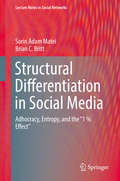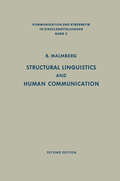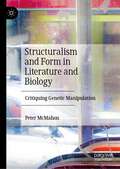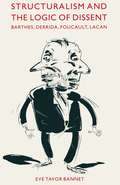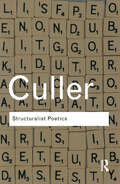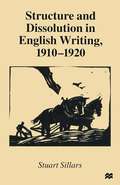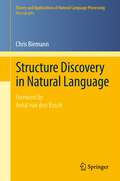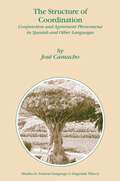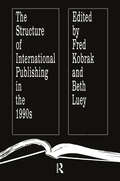- Table View
- List View
Structural Differentiation in Social Media: Adhocracy, Entropy, and the "1 % Effect" (Lecture Notes in Social Networks)
by Sorin Adam Matei Brian C. BrittThis book explores community dynamics within social media. Using Wikipedia as an example, the volume explores communities that rely upon commons-based peer production. Fundamental theoretical principles spanning such domains as organizational configurations, leadership roles, and social evolutionary theory are developed. In the context of Wikipedia, these theories explain how a functional elite of highly productive editors has emerged and why they are responsible for a majority of the content. It explains how the elite shapes the project and how this group tends to become stable and increasingly influential over time. Wikipedia has developed a new and resilient social hierarchy, an adhocracy, which combines features of traditional and new, online, social organizations. The book presents a set of practical approaches for using these theories in real-world practice. This work fundamentally changes the way we think about social media leadership and evolution, emphasizing the crucial contributions of leadership, of elite social roles, and of group global structure to the overall success and stability of large social media projects. Written in an accessible and direct style, the book will be of interest to academics as well as professionals with an interest in social media and commons-based peer production processes.
Structural Linguistics and Human Communication: An Introduction into the Mechanism of Language and the Methodology of Linguistics (Communication and Cybernetics #2)
by Bertil MalmbergThe point of departure of this general survey of modern structural linguistics is the place of language in human relations. Linguistics will consequently be understood as a science of communication. My book is not intended as an elementary handbook. The readers are supposed to be in the first place advanced students of linguistics and phonetics and of neighbouring fields where a real awareness of linguistic methods and problems is essential (such as psychology, phoniatrics, speech therapy, language teaching, communication engineering). The book may, however, be of some value also for the general reader who is interested in language, in language learning, or in communication processes. It might finally serve as an introduction to structural theories and practice for those linguists of traditional orientation who would like to make contact with the new trends in the study of language. It is self-evident that, under such circumstances, any reader will find certain chapters in this book rather complicated, others irritatingly elementary. This is, however, unavoidable in a work whose aim is to cover a vast field of knowledge and to offer the reader a synthesis of what appears at first sight to be widely disparate facts and phenomena. Many of the facts brought together here may, regarded superficially, seem to have few or no mutual connections. They can, nevertheless, be combined into a wide humanistic and scientific unity within which numerous lines of relationship bind together physical and psychic, individual and social phenomena.
Structural Models and African Poetics: Towards a Pragmatic Theory of Literature (Routledge Library Editions: Literary Theory)
by Sunday O. AnozieIn this pioneering work, first published in 1981, Sunday O. Anozie examines the relevance of structuralism and semiology to literary criticism in general and to African poetics in particular. Behind the growing body of African literature lies an immense reservoir of oral tradition for which the proper tools of analysis and interpretation have yet to be found. This book represents the first comprehensive full-scale exposition, analysis and critique of structuralism by a non-Western and non-European scholar. From an African viewpoint, it examines the roles to be played by structuralism and post-structuralism in the development of the general principles governing poetics and literary creativity in Africa. This title will be of interest to students of literature and literary theory.
Structural Models and African Poetics: Towards a Pragmatic Theory of Literature (Routledge Library Editions: Literary Theory)
by Sunday O. AnozieIn this pioneering work, first published in 1981, Sunday O. Anozie examines the relevance of structuralism and semiology to literary criticism in general and to African poetics in particular. Behind the growing body of African literature lies an immense reservoir of oral tradition for which the proper tools of analysis and interpretation have yet to be found. This book represents the first comprehensive full-scale exposition, analysis and critique of structuralism by a non-Western and non-European scholar. From an African viewpoint, it examines the roles to be played by structuralism and post-structuralism in the development of the general principles governing poetics and literary creativity in Africa. This title will be of interest to students of literature and literary theory.
Structuralism
by John SturrockJohn Sturrock’s classic explication of Structuralism represents the most succinct and balanced survey available of a major critical movement associated with the thought of such key figures as Lévi-Strauss, Foucault, Barthes, Lacan and Althusser theory. A classic work in literary and cultural theory. Reissued to coincide with calls for a return to structuralism. Includes a new introduction by Jean-Michel Rabaté, which explores developments in the reception of structuralist theory in the past five to ten years.
Structuralism and Form in Literature and Biology: Critiquing Genetic Manipulation
by Peter McMahonThe book considers biology in parallel with philosophical structuralism in order to argue that notions of form in the organism are analogous to similar ideas in structuralist philosophy and literary theory. This analogy is then used to shed light on debates among biological scientists from the turn of the 19th century to the present day, including Cuvier, Geoffroy Saint-Hilaire, Dawkins, Crick, Goodwin, Rosen and West-Eberhard. The book critiques the endorsement of genetic manipulation and bioengineering as keys to solving agricultural and environmental problems, suggesting that alternative models have been marginalized in the promotion of this discourse. Drawing from the work of philosophers including Cassirer, Saussure, Jakobson and Foucault the book ultimately argues that methods based on agroecology, supported by molecular applications (such as marker-assisted selection, MAS), can both advance agricultural development and remain focused on the whole organism.
Structuralism and Semiotics (New Accents)
by Terence HawkesPublished in 1977 as the first volume in the New Accents series, Structuralism and Semiotics made crucial debates in critical theory accessible to those with no prior knowledge of the field. Since then a generation of readers has used the book as an entry not only into structuralism and semiotics, but into the wide range of cultural and critical theories underpinned by these approaches.It remains the clearest introduction to some of the most important topics in modern critical theory. A new afterword and fresh suggestions for further reading complete this new edition.
Structuralism and Semiotics (New Accents)
by Terence HawkesPublished in 1977 as the first volume in the New Accents series, Structuralism and Semiotics made crucial debates in critical theory accessible to those with no prior knowledge of the field. Since then a generation of readers has used the book as an entry not only into structuralism and semiotics, but into the wide range of cultural and critical theories underpinned by these approaches.It remains the clearest introduction to some of the most important topics in modern critical theory. A new afterword and fresh suggestions for further reading complete this new edition.
Structuralism and the Logic of Dissent: Barthes, Derrida, Foucault, Lacan
by Eve Tavor BannetStructuralism and the Logic of Dissent is a fascinating and lucid exploration of the seminal writings of four eminent French structuralists that sheds new light on influential theoretical texts. Eve Tavor Bannet discusses the work of Barthes, Derrida, Foucault, and Lacan as coherent philosophical fictions, showing their contradictory political, social, and pedagogical implications and their complex historicity.
Structuralist Poetics: Structuralism, Linguistics And The Study Of Literature (Routledge Classics Ser. (PDF))
by Jonathan CullerA work of technical skill as well as outstanding literary merit, Structuralist Poetics was awarded the 1975 James Russell Lowell Prize of the Modern Language Association. It was during the writing of this book that Culler developed his now famous and remarkably complex theory of poetics and narrative, and while never a populariser he nonetheless makes it crystal clear within these pages.
Structuralist Poetics: Structuralism, Linguistics and the Study of Literature (Routledge Classics)
by Jonathan CullerA work of technical skill as well as outstanding literary merit, Structuralist Poetics was awarded the 1975 James Russell Lowell Prize of the Modern Language Association. It was during the writing of this book that Culler developed his now famous and remarkably complex theory of poetics and narrative, and while never a populariser he nonetheless makes it crystal clear within these pages.
Structuralist Poetics: Structuralism, Linguistics and the Study of Literature (Routledge Classics)
by Jonathan CullerA work of technical skill as well as outstanding literary merit, Structuralist Poetics was awarded the 1975 James Russell Lowell Prize of the Modern Language Association. It was during the writing of this book that Culler developed his now famous and remarkably complex theory of poetics and narrative, and while never a populariser he nonetheless makes it crystal clear within these pages.
Structure and Dissolution in English Writing, 1910–1920
by Stuart SillarsThis book explores key texts - Howards End , The Rainbow , and the poetry of Owen, Sassoon and Edward Thomas - to show the mingled continuation and rejection of convention as their characteristic achievement, exploring features often seen as failures. It also discusses the writing's increasing concern with the inadequacies of language, seeing it within the frame of contemporary society and deconstructive theory, and attempting to locate them in relation to high Modernism.
Structure and Meaning in English: A Guide for Teachers
by Graeme KennedyStructure and Meaning in English is designed to help teachers of English develop an understanding of those aspects of English which are especially relevant for learners who speak other languages. Using corpus research, Graeme Kennedy cuts to the heart of what is important in the teaching of English. The book provides pedagogically- relevant information about English at the levels of sounds, words, sentences and texts. It draws attention to those linguistic items and processes which research has shown are typically hard for learners and which lead to errors. Each chapter contains: a description of one or more aspects of English an outline of typical errors or problems for learners specific learning objectives listed at the beginning of each chapter exercises or tasks based on ‘real English’ taken from newspapers and other sources. discussion topics which can be worked through independently either as part of a course, or self study With answers to many of the tasks given at the back of the book, this groundbreaking work provides a comprehensive and accessible textbook on the structure and use of the language for teachers of English.
Structure and Meaning in English: A Guide for Teachers
by Graeme KennedyStructure and Meaning in English is designed to help teachers of English develop an understanding of those aspects of English which are especially relevant for learners who speak other languages. Using corpus research, Graeme Kennedy cuts to the heart of what is important in the teaching of English. The book provides pedagogically- relevant information about English at the levels of sounds, words, sentences and texts. It draws attention to those linguistic items and processes which research has shown are typically hard for learners and which lead to errors. Each chapter contains: a description of one or more aspects of English an outline of typical errors or problems for learners specific learning objectives listed at the beginning of each chapter exercises or tasks based on ‘real English’ taken from newspapers and other sources. discussion topics which can be worked through independently either as part of a course, or self study With answers to many of the tasks given at the back of the book, this groundbreaking work provides a comprehensive and accessible textbook on the structure and use of the language for teachers of English.
Structure Discovery in Natural Language (Theory and Applications of Natural Language Processing)
by Chris BiemannCurrent language technology is dominated by approaches that either enumerate a large set of rules, or are focused on a large amount of manually labelled data. The creation of both is time-consuming and expensive, which is commonly thought to be the reason why automated natural language understanding has still not made its way into “real-life” applications yet. This book sets an ambitious goal: to shift the development of language processing systems to a much more automated setting than previous works. A new approach is defined: what if computers analysed large samples of language data on their own, identifying structural regularities that perform the necessary abstractions and generalisations in order to better understand language in the process?After defining the framework of Structure Discovery and shedding light on the nature and the graphic structure of natural language data, several procedures are described that do exactly this: let the computer discover structures without supervision in order to boost the performance of language technology applications. Here, multilingual documents are sorted by language, word classes are identified, and semantic ambiguities are discovered and resolved without using a dictionary or other explicit human input. The book concludes with an outlook on the possibilities implied by this paradigm and sets the methods in perspective to human computer interaction.The target audience are academics on all levels (undergraduate and graduate students, lecturers and professors) working in the fields of natural language processing and computational linguistics, as well as natural language engineers who are seeking to improve their systems.
The Structure of Arabic: A Workbook in the Ten Measures
by David DiMeo Inas HassanThe Structure of Arabic: A Workbook in the Ten Measures is a comprehensive guide and workbook in the ten measures of Arabic words, the backbone of the Arabic lexical system, and provides a systematic explanation of the root and pattern system that forms the basis of most Arabic words. Successful Arabic learners have long recognized mastery of these measures and patterns as key to understand the Arabic language. With knowledge of this system, learners will be able to predict the meaning of unfamiliar words, recognize the function of words, and understand correct pronunciation of Arabic words, making vocabulary acquisition and retention easier. This unique textbook introduces measures and patterns sequentially across ten chapters, helping learners to navigate the topics in a logical manner. Without complicated jargon or technical language, this easy-to-understand textbook demystifies key topics in Arabic grammar. Comparative sentences which encapsulate the differences between measures give context, and exercises within the chapters serve to consolidate the learners’ grasp of the material presented.Designed to supplement both class-based Arabic courses and independent study, The Structure of Arabic will help learners of Arabic at all levels of competency to improve their vocabulary, pronunciation, spelling, and comprehension.
The Structure of Arabic: A Workbook in the Ten Measures
by David DiMeo Inas HassanThe Structure of Arabic: A Workbook in the Ten Measures is a comprehensive guide and workbook in the ten measures of Arabic words, the backbone of the Arabic lexical system, and provides a systematic explanation of the root and pattern system that forms the basis of most Arabic words. Successful Arabic learners have long recognized mastery of these measures and patterns as key to understand the Arabic language. With knowledge of this system, learners will be able to predict the meaning of unfamiliar words, recognize the function of words, and understand correct pronunciation of Arabic words, making vocabulary acquisition and retention easier. This unique textbook introduces measures and patterns sequentially across ten chapters, helping learners to navigate the topics in a logical manner. Without complicated jargon or technical language, this easy-to-understand textbook demystifies key topics in Arabic grammar. Comparative sentences which encapsulate the differences between measures give context, and exercises within the chapters serve to consolidate the learners’ grasp of the material presented.Designed to supplement both class-based Arabic courses and independent study, The Structure of Arabic will help learners of Arabic at all levels of competency to improve their vocabulary, pronunciation, spelling, and comprehension.
The Structure of Coordination: Conjunction and Agreement Phenomena in Spanish and Other Languages (Studies in Natural Language and Linguistic Theory #57)
by J. CamachoThis book analyzes the structure of coordination from two perspectives: the symmetrical properties the construction imposes on its conjuncts, and how conjuncts interact with other categories outside coordination with respect to agreement and other grammatical phenomena. A substantial amount of data represented in this book are taken from varieties of Spanish. Unlike English, Spanish has a rich pattern of overt agreement between the subject and the verb, between nouns and adjectives, and also between clitics and lexical DP objects and indirect objects. Spanish agreement paradigms reveal very interesting patterns of agreement mismatch that provide important theoretical insights. Unless otherwise specified, it can be assumed that non-English examples are from Spanish. IX CHAPTER #1 INTRODUCTION Although coordination has figured more or less steadily in the Generative tradition beginning with Chornsky's (1957) Conjunction Transformation (later known as Conjunction Reduction), until recently, the two prevailing areas of research had been ellipsis (see, for example, Van Oirsouw 1987) and the semantic interpretation of conjuncts.' The internal structure of coordination was usually left unanalyzed, or assumed to be ternary branching, as in (I).
The Structure of CP and IP: The Cartography of Syntactic Structures, Volume 2 (Oxford Studies in Comparative Syntax)
by Luigi RizziThe study of syntactic complexity and the identification of the elementary structural units involved have always been a component of research in the field of theoretical syntax. Still, these topics have recently acquired a higher degree of prominence and autonomy, which has led to an expansion in the ways syntacticians conceptualize syntactic representations and their interactions with other research topics. The Structure of CP and IP is the second volume in the Cartography of Syntactic Structures, a subgroup within the Oxford Studies in Comparative Syntax series. Funded by the Italian Ministry of Education, this research endeavor gave rise to the publication of the first such volume, The Functional Structure of DP and IP, which focuses primarily on the structure of nominal expressions and on certain aspects of clausal expressions. This second edited volume examines the structure of the clauses, with special reference to the inflectional domain (IP) and the left peripheral field of the clause (CP). With contributions by a select group of syntacticians, The Structure of CP and IP will be useful to scholars with an interest in Italian, Romance, and comparative syntax, and of substantial value to all linguists interested in contemporary research in generative grammar.
The Structure of English Clauses (Routledge Library Editions: The English Language)
by David J. YoungFirst published in 1980, this book provides a clear and practical introduction to a wide variety of English structures. It concentrates on a large and crucial area of English grammar, which covers units of higher rank than words, and structures that have verbs rather than nouns as their nuclear elements. Throughout the book, David Young focuses on the English language as it is actually spoken. At every point his discussion of syntax is closely integrated with meaning, and he pays particular attention to the ways in which speakers of English signal their intensions. The author points out how verbal patterning is meaningful, and outlines the criteria used by grammarians to distinguish one structure from another. The result is an analytical framework that can be applied to any real-life text in order to understand its structure. This is a book that will encourage a realistic, exploratory and investigative attitude towards the English language.
The Structure of English Clauses (Routledge Library Editions: The English Language)
by David J. YoungFirst published in 1980, this book provides a clear and practical introduction to a wide variety of English structures. It concentrates on a large and crucial area of English grammar, which covers units of higher rank than words, and structures that have verbs rather than nouns as their nuclear elements. Throughout the book, David Young focuses on the English language as it is actually spoken. At every point his discussion of syntax is closely integrated with meaning, and he pays particular attention to the ways in which speakers of English signal their intensions. The author points out how verbal patterning is meaningful, and outlines the criteria used by grammarians to distinguish one structure from another. The result is an analytical framework that can be applied to any real-life text in order to understand its structure. This is a book that will encourage a realistic, exploratory and investigative attitude towards the English language.
The Structure of International Publishing in the 1990s
by Fred KobrakThe past decade has brought dramatic changes to the publishing industry. Publishing companies merged with one another or were bought by larger companies or media conglomerates; mergers and acquisitions crossed national boundaries and language barriers; technological advances altered the publication process and made available new media and the re-examination of the established print media. This volume examines these changes and illuminates the various prospects for the future of publishing in the coming decade.
The Structure of International Publishing in the 1990s
by Fred Kobrak Beth LueyThe past decade has brought dramatic changes to the publishing industry. Publishing companies merged with one another or were bought by larger companies or media conglomerates; mergers and acquisitions crossed national boundaries and language barriers; technological advances altered the publication process and made available new media and the re-examination of the established print media. This volume examines these changes and illuminates the various prospects for the future of publishing in the coming decade.
The Structure of Modern Standard French: A Student Grammar
by Maj-Britt Mosegaard HansenThis book is an advanced student's grammar of French that integrates traditional grammar with knowledge and insights from modern linguistics. Maj-Britt Mosegaard Hansen takes a structural approach to French grammar: she provides clear descriptions of grammatical rules based explicitly on syntactic structure, and places descriptive emphasis on instances where the grammatical structures of French differ from those used in corresponding contexts in English. The first part of the book provides an introduction to French sentence structure, before the following parts examine the grammar of verbs, nominals, particles, and clauses and sentences. The Structure of Modern Standard French will be a valuable resource for students of French at undergraduate level and beyond. It assumes some prior knowledge of French grammar but is designed to be accessible to those with no background in linguistics.
